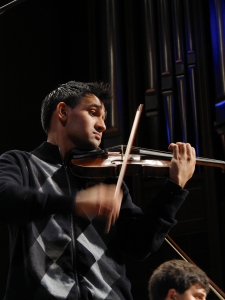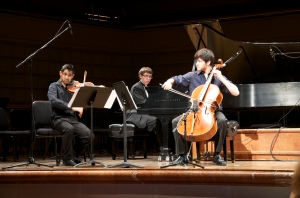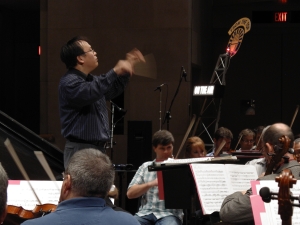Show 265: Listening Guide
From the Top’s broadcast for Show 265 featuring the Dallas Symphony Orchestra (DSO) was taped at the Morton H. Meyerson Symphony Center in Dallas, TX on Friday January 4, 2013. We asked our performers to tell us more about their experience on the show…
Aakash Patel, 19, violin
I. Allegro non troppo from Violin Concerto No. 3 in B minor, Op. 61
By: Camille Saint-Saëns
Saint-Saëns was a French composer, and French composers are known for their ability to create different  atmospheres with their talent for understanding different textures of various instruments. When I play this piece, I think of the different atmospheres that Saint-Saëns tried to create, and relate such atmospheres to my experiences with them. This has helped me gain a deeper insight into the beauty of Saint-Saëns third Violin Concerto.
atmospheres with their talent for understanding different textures of various instruments. When I play this piece, I think of the different atmospheres that Saint-Saëns tried to create, and relate such atmospheres to my experiences with them. This has helped me gain a deeper insight into the beauty of Saint-Saëns third Violin Concerto.
This piece contains some of the most beautiful lyrical passages I have ever played. This piece combines ideas of love and passion with a unique fluidity. For me it is a great challenge to convey this specific aspect of this piece. Although connecting the different portions of this piece together can be quite difficult, it is also quite rewarding. When I am able to convey this idea successfully, I get butterflies in my stomach.
Post-Show Reflection: I was asked, just before my performance, what it was like to finally be on the show – my response was, “pinch me, I’m dreaming!” 15 hours and many pinches later, my response should have been, “PLEASE REFRAIN FROM PINCHING!” From The Top has gotten me over so many hard blocks in my musical life – you guys keep my drive alive. Actually performing on the show was an unforgettable experience.
Many people say that man has the ability to move mountains. I was practicing outside a grocery store one day, and closed my eyes and began to play Bach’s G minor Sonata. After I finished, I opened my eyes and saw that an audience had formed – they all began to clap. I didn’t have to move any mountains, music had done it for me.
Russell Houston, 18, cello
Schelomo
By: Ernest Bloch
Whenever I play the Schelomo, I try to imagine it as the life story of a great king. I think it’s a cool piece to sit and play and really feel like a king, and the orchestra and solo parts contribute to this feeling. Further, it’s  really fun to play because the orchestra parts are just so fantastic. My favorite part is the last tutti, it sounds so grandiose and overwhelmingly beautiful. When I was a little kid I used to really like the movie The Ten Commandments, and that tutti reminded me of that movie the first time I heard it. From the first time I heard this piece, I was determined to work on it, and wouldn’t stop talking about how much I loved it.
really fun to play because the orchestra parts are just so fantastic. My favorite part is the last tutti, it sounds so grandiose and overwhelmingly beautiful. When I was a little kid I used to really like the movie The Ten Commandments, and that tutti reminded me of that movie the first time I heard it. From the first time I heard this piece, I was determined to work on it, and wouldn’t stop talking about how much I loved it.
What’s really cool about the Schelomo is that it isn’t like other concerti where technique is the most important part – the Schelomo is like a painting, in that each part contributes to this overall panorama. The most important thing to communicate is the character of Solomon – the piece is about him. It’s really hard to communicate that wisdom and maturity he has in his old age, especially since I’m only 18! This piece is really fun to perform because it’s just as much about the accompaniment as the solo!
Post-Show Reflection: I loved walking out on stage for the first time at the live show – it was so validating seeing how many people were out there! The performance was great! The hall feels great to perform in, and the size of the audience was more affirming than frightening.
I think music can change lives, from changing how you feel any time you listen to having a life full of music. Music is enriching for the soul and makes life better!
Chase Dobson, 16, composer/piano
II. Sporting of the Gods from Piano Trio No.1
By: Chase Dobson
This piece is full of energy. The driving rhythm is part of it, but there’s also an element of it that comes from  the three members of the trio together, all adding to the drive, competing with one another, but competing collaboratively. It takes a lot of precision to get the fine details together, but once it’s in performance, then the rush you get from it is unparalleled.
the three members of the trio together, all adding to the drive, competing with one another, but competing collaboratively. It takes a lot of precision to get the fine details together, but once it’s in performance, then the rush you get from it is unparalleled.
This composition is very special to me, in that it was the first composition I performed with live musicians. In the summer of 2011, I began rehearsing this trio with my friends Phoenix Abbo and Jorge Giron Vives. We prepared this movement for a benefit concert Phoenix was hosting, and we received a standing ovation at the performance, making the first public reception of my work very positive.
Post-Show Reflection: One of my favorite memories was Christopher O’Riley and the maestro’s rehearsal of the Shostakovich without the orchestral accompaniment – they both just hummed along during the piano breaks. I know it’s very specific, but it was so cool. It felt very comfortable to perform on that stage – there were so many steps to the actual performance that helped make it very easy, and very fun!
Music has the power to change live, bridge civilizations, entertain – essentially anything!
Greater Dallas Youth Orchestra (in a side-by-side performance with the DSO)
“The Great Gate of Kiev” from Pictures at an Exhibition
By: Modest Mussorgsky (orch. by Maurice Ravel)
Tiffany Mourlam, 18, viola
I absolutely love the Pictures at an Exhibition, and the “Great Gate of Kiev” is one of my favorite movements. I love the great contrasts between sections of the piece and how incredible the ending sounds. It’s one of the  most magical pieces of music EVER. My favorite part is definitely the beginning, where the brass play the theme. It just feels so good to sit and listen to. I also enjoy the sections where the strings rest and the winds have a few bars to enjoy the music and transitions between sections of the piece. There’s nothing about this piece that I dislike!
most magical pieces of music EVER. My favorite part is definitely the beginning, where the brass play the theme. It just feels so good to sit and listen to. I also enjoy the sections where the strings rest and the winds have a few bars to enjoy the music and transitions between sections of the piece. There’s nothing about this piece that I dislike!
The orchestration is incredible! Ravel was truly a master of orchestration, and I really like the way he chose to bring Mussorgsky’s ideas about the piece (as well as his own) into the music. It’s critical that the contrasts in this piece are pronounced because Ravel asks for so many different sounds and colors in Pictures at an Exhibition. The hardest thing was to achieve that difference in tone and color. I’ve loved this piece since I heard it as a child. Getting to play it is so fulfilling!
Post-Show Reflection: It was an incredible three days! I loved my backstage naps with Annie, and getting to introduce Mr. O’Riley and Tom (Voegli) to the extremely comfortable red chairs in the lounge. I also loved meeting my stand partner Valerie. The performance was incredible! The musicians were all so nice. At one point, I just looked around and couldn’t believe we were sitting with the DSO – one of my greatest childhood dreams come true!
Music has the power to connect people and change lives! I firmly believe that it has the power to promote peace and heal people.
Morgan Mitchell, 16, cello
Honestly the adrenaline rush I get from the Baba Yagá (the previous movement) is still with me, so the opening chords help me calm down and proceed. I absolutely love the dynamic contrasts because they keep me interested in what I am playing. My favorite memory of playing the piece was from this past summer in  Litomyšl, because we were performing in a castle (a girl’s favorite place!) and I could feel everyone around me giving 100%.
Litomyšl, because we were performing in a castle (a girl’s favorite place!) and I could feel everyone around me giving 100%.
This particular movement gives me the responsibility to convey and evoke emotion. It takes you out of your own brain and problems into a world of beauty and empowerment. The hardest things about the movement are sustaining the long notes with full pwer, and feeling as an ensemble. Compared to other pieces this one is not about virtuosity or showing off – it is about reflection.
Post-Show Reflection: Being on the Meyerson Hall stage sitting next to my teacher (who inspires me more than anyone) and feeling the realization of what I was doing was really powerful. The performance was the scariest, most special and humbling feeling ever. I love that stage, and everything it stands for in a musician’s life!
Music has the power to fill anything you do with passion by allowing you to give your all.
Annie Lehman, 18, harp
A sort of chordal texture starts the piece and quickly builds to (my favorite part) the big ending, which is so exhilarating to play and literally feel because you’re surrounded by the music when you are sitting in an orchestra.
Blending the sound with both the principle harpist and the rest of the orchestra is the most difficult part of learning this piece. Playing with a professional harpist adds a new dimension to playing in an orchestra, and provides a great learning experience.
Post-Show Reflection: My favorite moments were performing on the stage, being interviews by Christopher O’Riley, and seeing the behind-the-scenes of the show backstage. The show itself was AMAZING! I thought I would be nervous but I felt so comfortable talking and performing, and actually had tons of fun!
Music has the power to change everything – it can help others by allowing them bring across ideas that can’t be said with words, and can give you a knowledge of other cultures.




